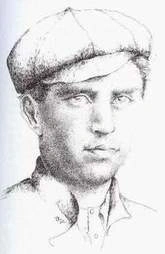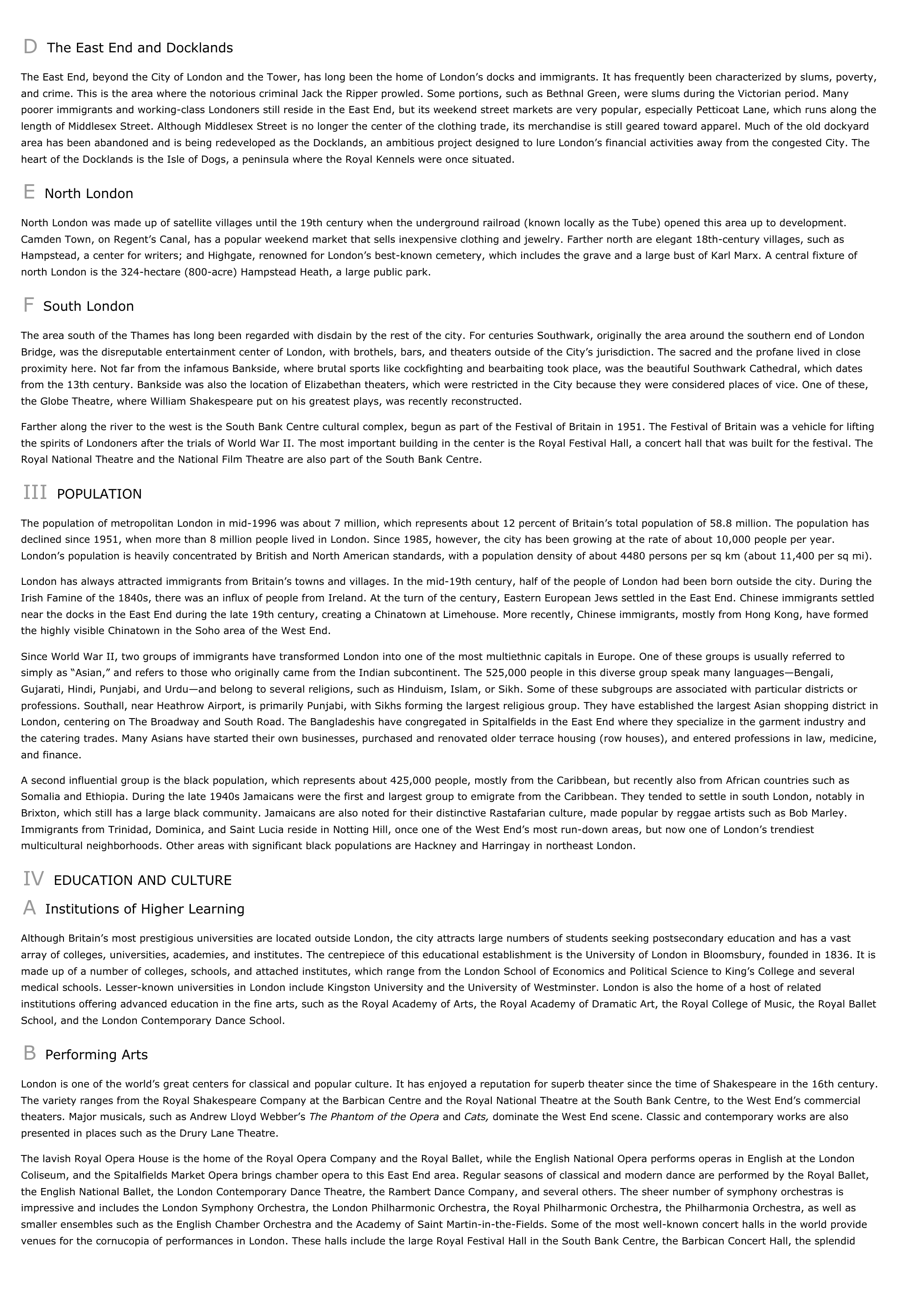London (England) - geography.
Publié le 27/05/2013
Extrait du document


«
D The East End and Docklands
The East End, beyond the City of London and the Tower, has long been the home of London’s docks and immigrants.
It has frequently been characterized by slums, poverty,and crime.
This is the area where the notorious criminal Jack the Ripper prowled.
Some portions, such as Bethnal Green, were slums during the Victorian period.
Manypoorer immigrants and working-class Londoners still reside in the East End, but its weekend street markets are very popular, especially Petticoat Lane, which runs along thelength of Middlesex Street.
Although Middlesex Street is no longer the center of the clothing trade, its merchandise is still geared toward apparel.
Much of the old dockyardarea has been abandoned and is being redeveloped as the Docklands, an ambitious project designed to lure London’s financial activities away from the congested City.
Theheart of the Docklands is the Isle of Dogs, a peninsula where the Royal Kennels were once situated.
E North London
North London was made up of satellite villages until the 19th century when the underground railroad (known locally as the Tube) opened this area up to development.Camden Town, on Regent’s Canal, has a popular weekend market that sells inexpensive clothing and jewelry.
Farther north are elegant 18th-century villages, such asHampstead, a center for writers; and Highgate, renowned for London’s best-known cemetery, which includes the grave and a large bust of Karl Marx.
A central fixture ofnorth London is the 324-hectare (800-acre) Hampstead Heath, a large public park.
F South London
The area south of the Thames has long been regarded with disdain by the rest of the city.
For centuries Southwark, originally the area around the southern end of LondonBridge, was the disreputable entertainment center of London, with brothels, bars, and theaters outside of the City’s jurisdiction.
The sacred and the profane lived in closeproximity here.
Not far from the infamous Bankside, where brutal sports like cockfighting and bearbaiting took place, was the beautiful Southwark Cathedral, which datesfrom the 13th century.
Bankside was also the location of Elizabethan theaters, which were restricted in the City because they were considered places of vice.
One of these,the Globe Theatre, where William Shakespeare put on his greatest plays, was recently reconstructed.
Farther along the river to the west is the South Bank Centre cultural complex, begun as part of the Festival of Britain in 1951.
The Festival of Britain was a vehicle for liftingthe spirits of Londoners after the trials of World War II.
The most important building in the center is the Royal Festival Hall, a concert hall that was built for the festival.
TheRoyal National Theatre and the National Film Theatre are also part of the South Bank Centre.
III POPULATION
The population of metropolitan London in mid-1996 was about 7 million, which represents about 12 percent of Britain’s total population of 58.8 million.
The population hasdeclined since 1951, when more than 8 million people lived in London.
Since 1985, however, the city has been growing at the rate of about 10,000 people per year.London’s population is heavily concentrated by British and North American standards, with a population density of about 4480 persons per sq km (about 11,400 per sq mi).
London has always attracted immigrants from Britain’s towns and villages.
In the mid-19th century, half of the people of London had been born outside the city.
During theIrish Famine of the 1840s, there was an influx of people from Ireland.
At the turn of the century, Eastern European Jews settled in the East End.
Chinese immigrants settlednear the docks in the East End during the late 19th century, creating a Chinatown at Limehouse.
More recently, Chinese immigrants, mostly from Hong Kong, have formedthe highly visible Chinatown in the Soho area of the West End.
Since World War II, two groups of immigrants have transformed London into one of the most multiethnic capitals in Europe.
One of these groups is usually referred tosimply as “Asian,” and refers to those who originally came from the Indian subcontinent.
The 525,000 people in this diverse group speak many languages—Bengali,Gujarati, Hindi, Punjabi, and Urdu—and belong to several religions, such as Hinduism, Islam, or Sikh.
Some of these subgroups are associated with particular districts orprofessions.
Southall, near Heathrow Airport, is primarily Punjabi, with Sikhs forming the largest religious group.
They have established the largest Asian shopping district inLondon, centering on The Broadway and South Road.
The Bangladeshis have congregated in Spitalfields in the East End where they specialize in the garment industry andthe catering trades.
Many Asians have started their own businesses, purchased and renovated older terrace housing (row houses), and entered professions in law, medicine,and finance.
A second influential group is the black population, which represents about 425,000 people, mostly from the Caribbean, but recently also from African countries such asSomalia and Ethiopia.
During the late 1940s Jamaicans were the first and largest group to emigrate from the Caribbean.
They tended to settle in south London, notably inBrixton, which still has a large black community.
Jamaicans are also noted for their distinctive Rastafarian culture, made popular by reggae artists such as Bob Marley.Immigrants from Trinidad, Dominica, and Saint Lucia reside in Notting Hill, once one of the West End’s most run-down areas, but now one of London’s trendiestmulticultural neighborhoods.
Other areas with significant black populations are Hackney and Harringay in northeast London.
IV EDUCATION AND CULTURE
A Institutions of Higher Learning
Although Britain’s most prestigious universities are located outside London, the city attracts large numbers of students seeking postsecondary education and has a vastarray of colleges, universities, academies, and institutes.
The centrepiece of this educational establishment is the University of London in Bloomsbury, founded in 1836.
It ismade up of a number of colleges, schools, and attached institutes, which range from the London School of Economics and Political Science to King’s College and severalmedical schools.
Lesser-known universities in London include Kingston University and the University of Westminster.
London is also the home of a host of relatedinstitutions offering advanced education in the fine arts, such as the Royal Academy of Arts, the Royal Academy of Dramatic Art, the Royal College of Music, the Royal BalletSchool, and the London Contemporary Dance School.
B Performing Arts
London is one of the world’s great centers for classical and popular culture.
It has enjoyed a reputation for superb theater since the time of Shakespeare in the 16th century.The variety ranges from the Royal Shakespeare Company at the Barbican Centre and the Royal National Theatre at the South Bank Centre, to the West End’s commercialtheaters.
Major musicals, such as Andrew Lloyd Webber’s The Phantom of the Opera and Cats, dominate the West End scene.
Classic and contemporary works are also presented in places such as the Drury Lane Theatre.
The lavish Royal Opera House is the home of the Royal Opera Company and the Royal Ballet, while the English National Opera performs operas in English at the LondonColiseum, and the Spitalfields Market Opera brings chamber opera to this East End area.
Regular seasons of classical and modern dance are performed by the Royal Ballet,the English National Ballet, the London Contemporary Dance Theatre, the Rambert Dance Company, and several others.
The sheer number of symphony orchestras isimpressive and includes the London Symphony Orchestra, the London Philharmonic Orchestra, the Royal Philharmonic Orchestra, the Philharmonia Orchestra, as well assmaller ensembles such as the English Chamber Orchestra and the Academy of Saint Martin-in-the-Fields.
Some of the most well-known concert halls in the world providevenues for the cornucopia of performances in London.
These halls include the large Royal Festival Hall in the South Bank Centre, the Barbican Concert Hall, the splendid.
»
↓↓↓ APERÇU DU DOCUMENT ↓↓↓
Liens utiles
- London (England) - geography.
- Ne pas confondre Grande Bretagne et Royaume Uni Great Britain Great Britain is made up of: England - The capital is London.
- Tower of London, England - art.
- APPEL DE LA FORÊT (L') (résumé & analyse) de Jack (John Griffith) London
- MÈRE ANGLETERRE [England Made Me]. Graham Green (résumé)

































